Description
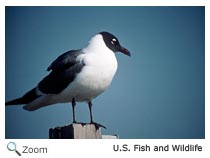 The laughing gull is medium-sized gull 15-17
inches in length, with a wingspan of
37-47
inches. It has a black head and neck; a white breast and belly; a slate gray back; slate gray wings with back tips; and a dark red bill that is slightly hooked on the end. Its feet and legs are a reddish black. In the winter, its black head is greyish-white. Males and females look alike. The laughing gull is medium-sized gull 15-17
inches in length, with a wingspan of
37-47
inches. It has a black head and neck; a white breast and belly; a slate gray back; slate gray wings with back tips; and a dark red bill that is slightly hooked on the end. Its feet and legs are a reddish black. In the winter, its black head is greyish-white. Males and females look alike.
Range
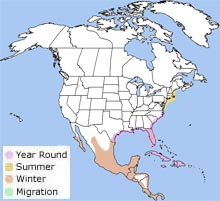 The laughing gull breeds along the Atlantic Coast from Canada south to Florida and the Caribbean and along the Gulf Coast. It winters from Virginia south to South America and along the Gulf Coast, Mexico, and the Caribbean.
The laughing gull is rarely found inland, and usually it is not found far out at sea. The laughing gull breeds along the Atlantic Coast from Canada south to Florida and the Caribbean and along the Gulf Coast. It winters from Virginia south to South America and along the Gulf Coast, Mexico, and the Caribbean.
The laughing gull is rarely found inland, and usually it is not found far out at sea.
Habitat
The laughing gull is found on marshes, beaches, barrier islands, estuaries, and bays. |
|
Diet
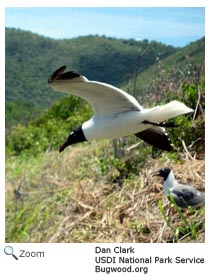 The laughing gull
eats
mollusks, fish, bird eggs, young birds, squid, crabs and other
crustaceans, insects, carrion, and garbage.
It feeds on the water and on land. It swoops down to the water and skims the surface for food or it dives into the water. It also scavenges for food on land and it catches insects in the air, in fact, if food is tossed in the air, the laughing gull can easily snatch it up!
It also fights other birds for food! The laughing gull
eats
mollusks, fish, bird eggs, young birds, squid, crabs and other
crustaceans, insects, carrion, and garbage.
It feeds on the water and on land. It swoops down to the water and skims the surface for food or it dives into the water. It also scavenges for food on land and it catches insects in the air, in fact, if food is tossed in the air, the laughing gull can easily snatch it up!
It also fights other birds for food!
Life Cycle
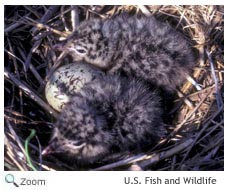 The laughing gull nests in colonies with other gulls and terns. The male and female build a platform nest of grass and weeds placed in in
tall grass or shrubs. Occasionally, the laughing gull nests on open ground.
The female lays 2-4 eggs. The eggs are incubated for 20-23 days by both parents.
Chicks leave the nest a few days after hatching, but their parents care for them until they fledge when they are 35 days old. The laughing gull nests in colonies with other gulls and terns. The male and female build a platform nest of grass and weeds placed in in
tall grass or shrubs. Occasionally, the laughing gull nests on open ground.
The female lays 2-4 eggs. The eggs are incubated for 20-23 days by both parents.
Chicks leave the nest a few days after hatching, but their parents care for them until they fledge when they are 35 days old.
Behavior
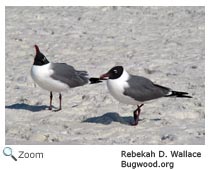 The laughing gull gets it name for its loud and high-pitched
"ha ha ha ha ha ha" laughing call. It is a social bird and hunts, rests, nests, and migrates in groups. The laughing gull gets it name for its loud and high-pitched
"ha ha ha ha ha ha" laughing call. It is a social bird and hunts, rests, nests, and migrates in groups.
|



 The laughing gull breeds along the Atlantic Coast from Canada south to Florida and the Caribbean and along the Gulf Coast. It winters from Virginia south to South America and along the Gulf Coast, Mexico, and the Caribbean.
The laughing gull is rarely found inland, and usually it is not found far out at sea.
The laughing gull breeds along the Atlantic Coast from Canada south to Florida and the Caribbean and along the Gulf Coast. It winters from Virginia south to South America and along the Gulf Coast, Mexico, and the Caribbean.
The laughing gull is rarely found inland, and usually it is not found far out at sea. 

